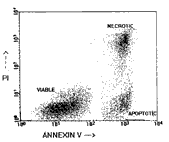Rapid and reliable method for detection of apoptosis
Features
- Rapid and reliable method for detection of apoptosis
- Flow cytometry test
- Detection at single cell level
- Distinction between apoptosis and necrosis
Applications
- Monitor cell death is important in a wide variety of clinical situations
- Frequent application is monitoring cell death during tumor therapy
For research only. Not for use in humans
Introduction
Apoptosis or programmed cell death (PCD) is a genetically encoded cell elimination program which ensures an equilibrium between cell proliferation and cell death and by which damaged or unwanted cells are eliminated. Therefore it is important to stress that apoptosis is a normal physiological process. Without continuous signaling by growth factors, hormones or cytokines, all cells undergo PCD.
Aberrations in the mechanism of apoptosis occur in congenital defects, malignancies, auto-immune diseases, immune deficiency syndromes and in degenerative conditions.
Principle of the Phosphatidyl Serine Detection Kit
Phosphatidyl Serine (PS) becomes exposed on the outside of the cell membrane. In vivo, this is a signal to phagocytes to engulf the dying cell before it loses its plasma membrane integrity and releases inflammatory mediators into the surroundings. This early stage of apoptosis can be specifically detected by PS binding proteins.
During the early stage of apoptosis, the cell membrane is intact and the cells exclude propidium iodide (PI). Later, during the apoptotic process in vitro, the membrane becomes porous and PI becomes associated with DNA in the nucleus. The uptake of PI is an indication of necrosis.
Annexin V is a phospholipid binding protein which exhibits high affinity and selective binding to phosphotidylserine in the presence of calcium ions. It is a highly specific marker of apoptosis.
In a single cell suspension, cells can be analyzed using the Phosphatidyl Serine Detection Kit, which contains the PS binding protein, Annexin V FITC plus calcium buffer and PI.

Figure 1 (a) Flow cytometry analysis of peripheral blood lymphocytes labeled with Annexin V FITC and propidium iodide (PI) after overnight incubation with dexamethasone to induce apoptosis. Apoptotic cells exclude PI and express PS. Necrotic or dead cells are permeable to PI which associates with nuclear DNA and is visible as red fluorescence. The cytogram shows viable cells (lower left), apoptotic cells (lower right) and apoptotic cells which have lost plasma membrane integrity (upper right).
Figure 1 (b) Dual staining with Annexin V and a monoclonal antibody to the membrane antigen CD3 after overnight incubation with dexamethasone. CD3 positive lymphocytes which have begun to undergo apoptosis are seen in the upper right quadrant.
1. Green, D.R., and Martin, S.J., 1995. The killer and the executioner: how apoptosis controls malignancy. Curr.opin. Immunol. 7: 694-703
2. Jacobson, M.D., 1997. Programmed cell death in animal development. Cell 88: 347-354
3. Vermes et al. 1995. A novel assay for apoptosis: Flow cytometric detection of phosphatidylserine expression on early apoptotic cells using fluorescein labeled Annexin V. J. Immunol. Methods. 184. 39-51
4. Martin, S.J., et al., 1995. Early redistribution of plasma membrane phosphatidylserine is a general feature of apoptosis regardless of the initiating stimulus. Inhibition by over expression of Bcl-2 and Abl.. J.Exp. Med. 182, 1545 – 1557
5. Koopman et al. 1994. Annexin V for flow cytometric detection of phosphatidylserine expression on B cells undergoing apoptosis. Blood. 84, 1415-1420